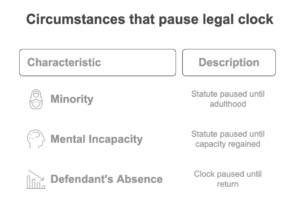So, you’ve been injured, and you think someone else is to blame. Maybe it was a car accident, a slip and fall, or something more complicated. You’re probably focused on getting better, and rightly so. But there’s something else you absolutely need to understand: the statute of limitations. Missing it can mean kissing your chance for compensation goodbye.
Understanding the Personal Injury Statute of Limitations: Why Timing is Everything
Think of a statute of limitations as a legal deadline. It’s the timeframe you have to file a lawsuit after an accident or injury. These deadlines exist to ensure fairness – memories fade, evidence disappears, and witnesses move on. Courts want cases to be based on fresh, reliable information.
In the context of a personal injury, this means you have a set period to officially begin your case by filing the necessary paperwork with the court. Miss this deadline, and the court will likely dismiss your case, regardless of how strong it might otherwise be. No exceptions (well, almost – we’ll get to those later!).
What Triggers the Statute of Limitations in a Personal Injury Claim?
Generally, the clock starts ticking from the date of the incident that caused your injury. This seems straightforward enough for something like a car crash. But what if the injury isn’t immediately obvious? This is where things can get a little trickier.
The specific laws vary by state, but the basic principle is the same: file your case promptly.
Navigating Exceptions to the Personal Injury Statute of Limitations
Okay, so there are a few exceptions to the hard-and-fast deadline. These are called “tolling” provisions, meaning they temporarily pause the clock.

Common reasons for tolling include:
- Minority: If the injured person is a minor (under 18), the statute of limitations usually doesn’t begin running until they reach adulthood.
- Mental Incapacity: If the injured person is mentally incapacitated, the statute may be paused until they regain capacity.
- Defendant’s Absence: If the person who caused the injury leaves the state to avoid being served with a lawsuit, the clock may be paused until they return.
These exceptions are highly fact-specific, so it’s essential to consult with a lawyer to determine if any apply to your situation.
Discovering Your Injury: The Discovery Rule and Your Claim
What happens when you don’t realise you’ve been injured until long after the initial event? This is where the “discovery rule” comes in. The discovery rule states that the statute of limitations doesn’t begin until you discover (or reasonably should have discovered) that you’ve been injured and that the injury was caused by someone else’s negligence.

Think about these scenarios:
- Asbestos Exposure: Imagine someone who worked with asbestos decades ago and is now diagnosed with mesothelioma. The statute of limitations wouldn’t start when they were exposed to asbestos; it would start when they were diagnosed with the disease and had reason to believe the asbestos exposure was the cause.
- Medical Malpractice: A patient might not realise a surgeon left a foreign object inside them until months (or even years) later, when they experience complications. The clock would likely start when they discovered the object, not the date of the surgery.
- Defective Products: You bought some baby powder, and years later, developed cancer. You didn’t know the powder was bad, and only realised it when there were reports about it, or you were diagnosed with cancer.
The discovery rule can be complex. Courts will consider when a reasonable person in your situation would have known about the injury and its cause.
Filing Your Personal Injury Claim: Beating the Statute of Limitations Deadline
The best way to “beat” the statute of limitations? File your lawsuit well before the deadline. Don’t wait until the last minute. Remember, filing a lawsuit involves more than just walking into the courthouse. It requires gathering evidence, preparing legal documents, and serving the defendant. This takes time!
Pro Tip: Treat the statute of limitations as a drop-dead date. Mark it on your calendar, set reminders, and make sure your attorney knows about it.
Consequences of Missing the Personal Injury Statute of Limitations
The consequences of missing the deadline are severe. The court will likely dismiss your case with prejudice, meaning you can’t refile it. You will lose your right to pursue compensation for your injuries, medical bills, lost wages, and pain and suffering. In short, you’ll be out of luck.
Seeking Legal Advice: Protect Your Right to File a Personal Injury Claim
Given the complexities of personal injury law and the strictness of statutes of limitations, consulting with an experienced personal injury attorney is crucial. An attorney can:
- Determine the applicable statute of limitations in your case.
- Investigate your claim and gather evidence.
- Navigate any exceptions to the statute of limitations that may apply.
- File your lawsuit on time to protect your rights.
- Negotiate with insurance companies. (Insurance companies are VERY aware of these deadlines, and will use them to their advantage in negotiations!)
Don’t gamble with your future. Get the legal help you need to ensure your claim is filed correctly and on time. Contact a personal injury attorney today!




